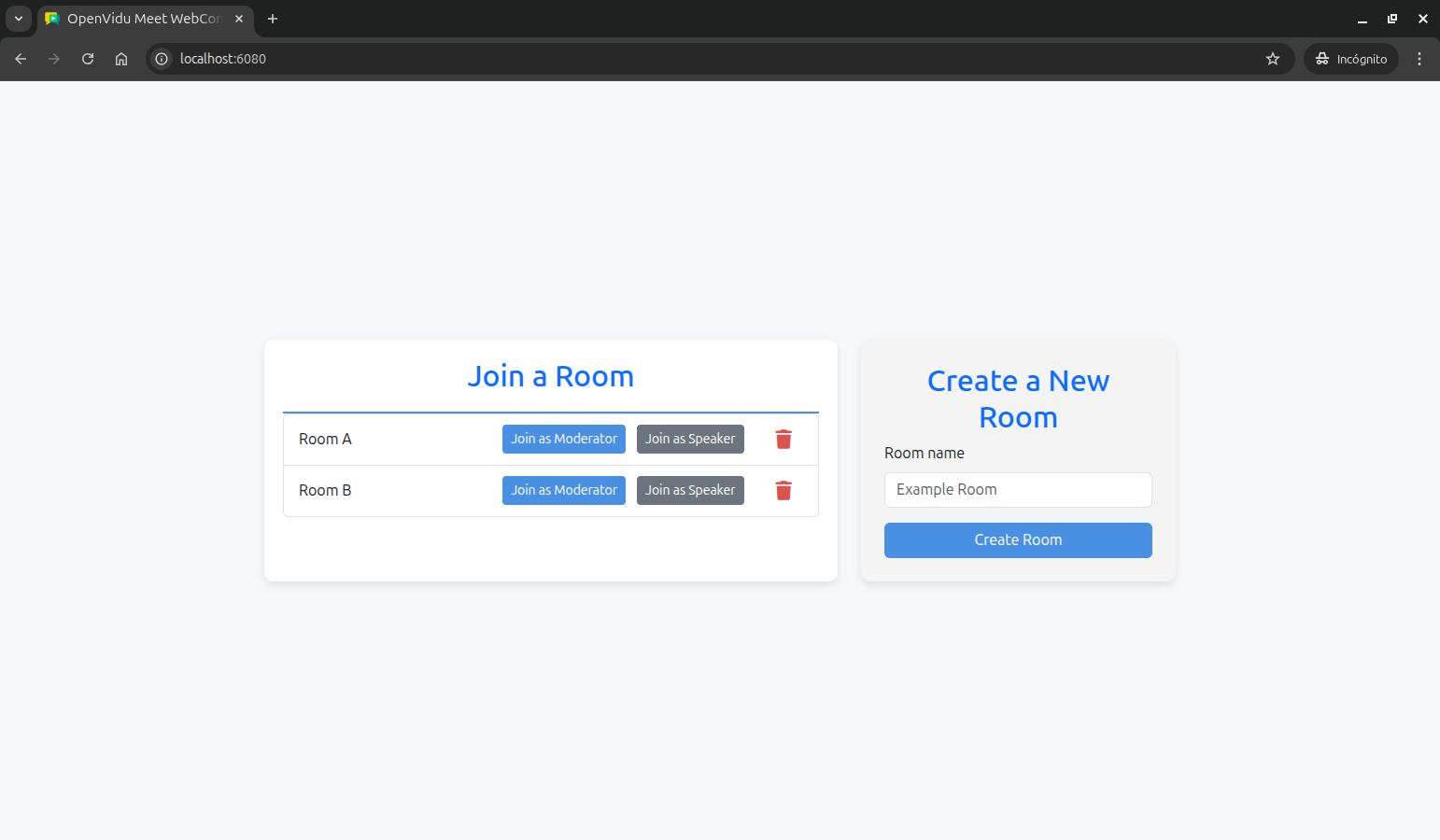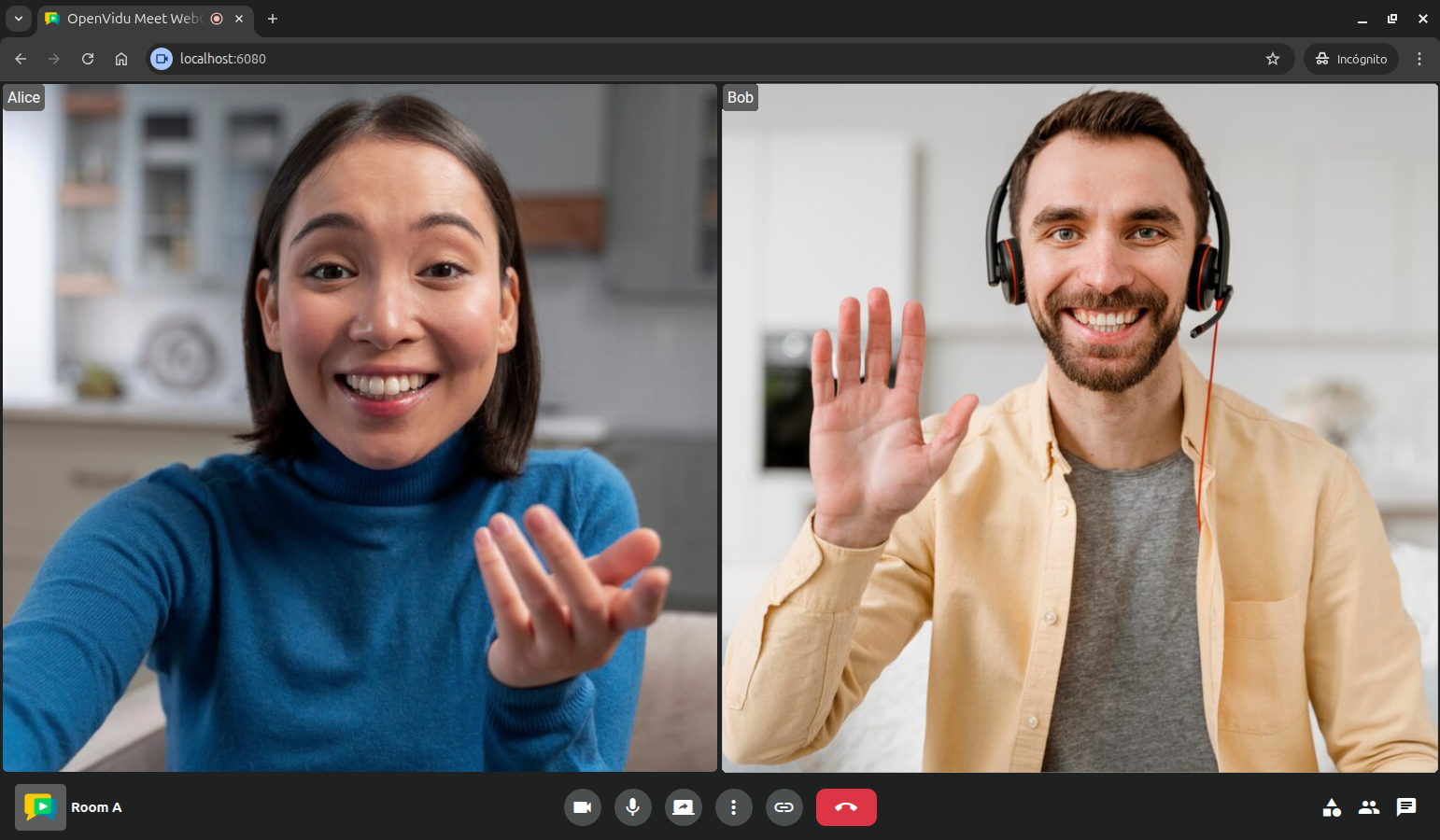OpenVidu Meet WebComponent Tutorial#
This tutorial extends the Direct Link tutorial by integrating the OpenVidu Meet WebComponent directly into your application instead of using external links. It is built using Node.js and Express for the backend and plain HTML/CSS/JavaScript for the frontend.
At the end of this tutorial, you will have a fully functional simple video-call application with the following features:
- Users can create rooms.
- Users can delete rooms.
- Users can join a room as moderator or speaker.
- Users can chat with other users.
- Users may leave the room at any time.
- Users can view the recordings of the meeting.
- Moderators can record the meeting.
- Moderators may end the meeting at any time, disconnecting all users.
The application uses the OpenVidu Meet API to create and delete rooms, and the OpenVidu Meet WebComponent to embed the video call interface directly into the application.
Running this tutorial#
1. Run OpenVidu Meet#
You need Docker Desktop. You can install it on Windows , Mac or Linux .
Run this command in Docker Desktop's terminal:
Info
For a detailed guide on how to run OpenVidu Meet locally, visit Try OpenVidu Meet locally .
2. Download the tutorial code#
3. Run the application#
To run this application, you need Node.js installed on your device.
- Navigate into the application directory
- Install dependencies
- Run the application
Once the server is up and running, you can test the application by visiting http://localhost:6080. You should see a screen like this:
Understanding the code#
This tutorial builds upon the Direct Link tutorial, replacing external redirect links with an embedded OpenVidu Meet WebComponent. The backend remains identical, so we'll focus on the frontend modifications that enable WebComponent integration.
Backend#
The backend is identical to the Direct Link tutorial. It provides the same three REST API endpoints:
POST /rooms: Create a new room with the given room name.GET /rooms: Get the list of rooms.DELETE /rooms/:roomId: Delete a room with the given room ID.
For detailed backend documentation, please refer to the Direct Link tutorial backend section.
Frontend modifications#
The main changes in the frontend involve replacing direct links with embedded WebComponent functionality. The key modifications are in the public/js/app.js and public/index.html files.
Including the OpenVidu Meet WebComponent#
To use the OpenVidu Meet WebComponent in your application, you need to include it in your HTML file by adding a script tag to the end of the <body> section:
Enhanced room list template#
The room list template has been modified to use buttons instead of direct links, enabling WebComponent integration:
| app.js | |
|---|---|
| |
The key difference from the Direct Link tutorial is that instead of using anchor tags (<a>) with href attributes pointing to external URLs, this template uses buttons that call the joinRoom() function with the appropriate room URL.
Joining a room with WebComponent#
When the user clicks the Join as Moderator or Join as Speaker button, the joinRoom() function is called, which handles embedding the OpenVidu Meet WebComponent:
| app.js | |
|---|---|
| |
- Hide the home screen to prepare for the meeting view.
- Show the room screen where the WebComponent will be embedded.
- Inject the OpenVidu Meet WebComponent into the meeting container with the specified room URL and a leave redirect URL.
The joinRoom() function hides the home screen and shows the room screen to provide a dedicated space for the video meeting. Then, it dynamically creates and injects the <openvidu-meet> WebComponent into the meeting container, setting the room-url attribute with the URL provided by the OpenVidu Meet API and configuring the leave-redirect-url attribute to return users to the home screen when they leave the meeting.
This approach provides a seamless user experience by keeping users within the same application while providing full video conferencing functionality through the embedded WebComponent.
Accessing this tutorial from other computers or phones#
To access this tutorial from other computers or phones, follow these steps:
-
Ensure network connectivity: Make sure your device (computer or phone) is connected to the same network as the machine running OpenVidu Meet and this tutorial.
-
Configure OpenVidu Meet for network access: Start OpenVidu Meet by following the instructions in the Accessing OpenVidu Meet from other computers or phones section.
-
Update the OpenVidu Meet server URL: Modify the
OV_MEET_SERVER_URLenvironment variable in your.envfile to match the URL shown when OpenVidu Meet starts. -
Update the OpenVidu Meet WebComponent script URL: In the
public/index.htmlfile, update the<script>tag that includes the OpenVidu Meet WebComponent to use the same base URL as above. -
Restart the tutorial to apply the changes:
-
Access the tutorial: Open your browser and navigate to
https://192-168-1-100.openvidu-local.dev:6443(replacing192-168-1-100with your actual private IP) on the computer where you started the tutorial or any device in the same network.
Connecting this tutorial to an OpenVidu Meet production deployment#
If you have a production deployment of OpenVidu Meet (installed in a server following deployment steps ), you can connect this tutorial to it by following these steps:
-
Update the server URL: Modify the
OV_MEET_SERVER_URLenvironment variable in the.envfile to point to your OpenVidu Meet production deployment URL. -
Update the API key: Ensure the
OV_MEET_API_KEYenvironment variable in the.envfile matches the API key configured in your production deployment. See Generate an API Key section to learn how to obtain it. -
Update the OpenVidu Meet WebComponent script URL: In the
public/index.htmlfile, update the<script>tag that includes the OpenVidu Meet WebComponent to use the same base URL as above. -
Restart the tutorial to apply the changes:
Make this tutorial accessible from other computers or phones
By default, this tutorial runs on http://localhost:6080 and is only accessible from the local machine. If you want to access it from other computers or phones, you have the following options:
- Use tunneling tools: Configure tools like VS Code port forwarding , ngrok , localtunnel , or similar services to expose this tutorial to the internet with a secure (HTTPS) public URL.
- Deploy to a server: Upload this tutorial to a web server and configure it to be accessible with a secure (HTTPS) public URL. This can be done by updating the source code to manage SSL certificates or configuring a reverse proxy (e.g., Nginx, Apache) to serve it.

